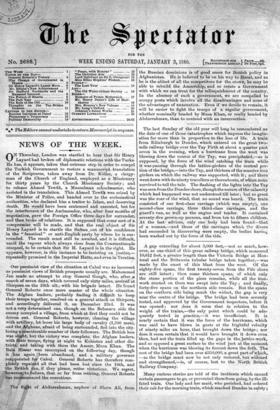A gap extending for about 3,000 feet,—not so much, how-
ever, as one-third of this great railway bridge, which measured 10,612 feet, a greater length than the Victoria Bridge at Mon- treal and the Britannia tubular bridge taken together,—was made by the onset of this blast from the west. Of the eighty-five spans, the first twenty-seven from the Fife shore are still intact ; then come thirteen spans, of which only the stone portion of the piers remains, while all the iron- work erected on them was swept into the Tay ; and finally, forty-five spans on the northern side remain. But the spans on the southern side being much the widest, the gap is very near the centre of the bridge. The bridge had been severely tested, and approved by the Government inspectors, before it was opened ; nor ,does it seem that in relation to the weight of the trains,—the only point which could be ade- quately tested in practice,—it was insufficient. It is nearly certain that it was the force of the hurricane, which was said to have blown in gusts at the frightful velocity of ninety miles an hour, that brought down the bridge ; nor does it seem certain that it would have brought it down even 'then, had not the train filled up the gaps in the lattice-work, and so opposed a great surface to the wind just at the moment when the hurricane MIS blowing its fiercest down the firth. The cost of the bridge had been over £350,000, a great part orwhich, —as the bridge must now be not only restored, but widened and strengtheited,—is, of course, lost to the North British Railway Company.










































 Previous page
Previous page